William Parks (publisher)
| William Parks | |
|---|---|
| Born |
May 23, 1699[1] Shropshire, England[2] |
| Died | April 1, 1750 (aged 50) [1] |
| Resting place | Gosport, England |
| Residence |
Annapolis, Maryland Colonial Williamsburg |
| Occupation | printer |
| Known for | publisher in colonial America |
| Spouse(s) | Eleanor[3] |
| Children |
William Parks Jr. (christened March 20, 1720) Eleanor (christened July 1721)[1] |
| Parent(s) |
William Parks (Sr.) Susanna (Lowe) Parks[2] |
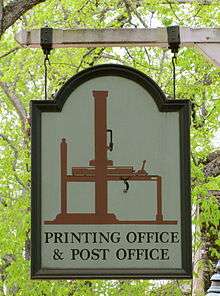
Duke of Gloucester St. (lot #48, block 18)

Colonial Williamsburg reconstruction[4]
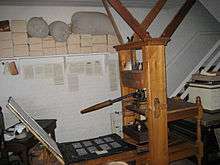

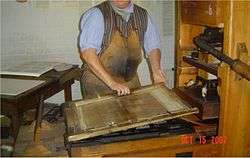
| Wikimedia Commons has media related to Williamsburg print shop. |
William Parks (1699–1750) was a printer and journalist in England and Colonial America.
Biography
Parks was born in Shropshire, England on May 23, 1699.[1] He was first a printer and newspaper publisher in England,[5] where he maintained printing houses at Ludlow, Hereford and Reading.[6] In Ludlow, Parks published the Ludlow Post-Man starting in 1719. In 1721 he moved to Hereford where he published two books. In July 1723 Parks operated a printing business in Reading, where he published The Reading Mercury with one D. Kinnier.[7]
Parks eventually moved to America in 1726 where he started a print shop in Annapolis, Maryland.[8] He soon became postmaster there.[7] His print shop served as the stage coach stop in Annapolis;[7] the Philadelphia American Weekly newspaper featured an advertisement on April 4, 1728, which mentions the stagecoach stopping in Annapolis at Parks's post office.[7]
Parks began publishing Maryland government documents in 1726[7] when he published the Acts of the Assembly for the colony.[9] In 1727 he became the first "public printer" (aka: "printer to the public") for the government of colonial Maryland, and was commissioned to print all government documents, which he did until 1737.[8] About 1730 he began a print shop in Colonial Williamsburg on Duke of Gloucester Street "near the Capitol".[4] Sometime shortly after 1737 he moved to the print shop familiar today as the tourist attraction on lot 48.[4] He became the first official government "public printer" for the colony of Virginia as well. Parks was then the government "public printer" for both colonies of Maryland and Virginia.[8] He was the "public printer" for the government of the colony of Virginia from 1730 to 1750,[10][11][12] and as Virginia's official "public printer", published the first official collection of Virginia's laws in 1733,[13] known as A Collection of all the Acts of Assembly, now in force, in the Colony of Virginia.[14]
Parks founded the Maryland Gazette newspaper in 1727, which he published continuously through 1734.[9] In the Maryland Gazette he published the poetry of Ebenezer Cook and Richard Lewis. He also published the ecclesiastical views of Reverend Jacob Henderson, the legal views of colonial lawyer Daniel Dulany and the views of other figures not very well known in the colonies at the time.[7]
Parks moved from Annapolis to Colonial Williamsburg permanently in 1736, where he was elected as Williamsburg's postmaster.[5] That same year, he founded Virginia's first newspaper, the Virginia Gazette.[15] The first issue was printed on August 6, 1736.[5] He published the newspaper until his death in 1750.[16]
Williamsburg paper mill
The history of Parks's Williamsburg paper mill began with his journey to Philadelphia in the fall of 1742 to consult with Benjamin Franklin. Franklin had advertised in the Pennsylvania Gazette for a contractor who knew about building a paper mill, and for associated craftsmen. Together, Parks and Franklin interviewed various people who responded to the ad. When Parks had to return to Williamsburg, he left Franklin in charge as his agent. Franklin hired a German contractor (Johan Conrad Shutz or "Scheetz") who knew how to build a paper mill, and hired skilled craftsmen. Franklin also obtained paper making equipment and furnished Parks with rags for the making the paper. Construction on the paper mill began in the fall of 1742, and was completed sometime in 1743.[17] At times Parks employed as many as nine assistants for his paper mill and nearby Williamsburg print shop.[18]
Shutz left Williamsburg and went back to Pennsylvania to start up his own paper mill in 1744.[15] Parks advertised for additional rags for his papermaking in the Virginia Gazette on July 26, 1744.[19] The Williamsburg paper mill established by Parks was the first paper mill in colonial America south of Pennsylvania,[20] and the first paper mill built in Virginia.[17] Historian J. A. Leo Lemay has speculated that the reason Franklin was so interested in seeing Parks getting started in the paper making business is that he wanted to promote American industry.[17]
It is not clear whether the mill continued to operate after the death of Parks in 1750. Williamsburg historian Rutherfoord Goodwin speculated that it may have been taken over by William Hunter, the new proprietor of the Virginia Gazette, who had served as Parks's main assistant. However, it is known that Hunter bought paper from Benjamin Franklin in 1751 and generally did not use Virginia paper. Thus it is also possible that Parks's paper mill was shut down and the equipment sold from the estate to Johan Conrad Shutz, the German contractor, for his new Pennsylvania mill.[19]
Works
Parks's major printing production as an official government "public printer" consisted of the 1733 Virginia Code, fourteen volumes of Acts of Assembly , and ten volumes of the Journal of the House of Burgesses . He also printed John Mercer's extensive An Exact Abridgement of All the Public Acts of Assembly of Virginia (1737, 1739) and New Kent County justice George Webb's sizeable edition of The Office and Authority of a Justice of Peace (1736).[21]
Another work printed by Parks was The Chapter of William and Mary College published in 1736. Parks also did the book binding for this work. He advertised himself as one "Who binds old Books very well, and cheap."[22]
Legacy
Parks established four new newspapers in his lifetime.[23]
- Two were in England: the Ludlow Post-Man and The Reading Mercury.[7]
- Two were in Colonial America: the Maryland Gazette[9] and the Virginia Gazette.[15]
Parks has been given credit for these "firsts":[24]
- First publications of literary works in Virginia.
- First paper mill south of Pennsylvania.
- First "public printer" in Virginia.
- First newspaper in Maryland.
- First postmaster of Virginia.
- First newspaper in Virginia.
Gallery of William Parks' printed publications
 1719 British newspaper "The Ludlow Post-Man"
1719 British newspaper "The Ludlow Post-Man" 1720 The most Important Question What is Truth Explained and Enlarged
1720 The most Important Question What is Truth Explained and Enlarged 1721 Dr. Prideux's Vindication of the Rule and Table for Finding Easter...
1721 Dr. Prideux's Vindication of the Rule and Table for Finding Easter... 1723 British newspaper
1723 British newspaper
"The Reading Mercury" 1724 Parks's British newspaper "Half-Penny London Journal"
1724 Parks's British newspaper "Half-Penny London Journal"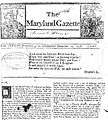 Maryland Gazette
Maryland Gazette
Dec 3 - 10, 1728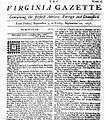 Virginia Gazette
Virginia Gazette
Sept 3-10, 1736 College of William & Mary charter and statutes 1736
College of William & Mary charter and statutes 1736
George Webb's 1736
office of "Justice of Peace" Complete collection of the 1727 Laws of Maryland
Complete collection of the 1727 Laws of Maryland
1730 Typographia
An Ode on Printing 1733 Acts of Assembly for the Colony of Virginia
1733 Acts of Assembly for the Colony of Virginia 1747 History of Discovery and Settlement of Virginia
1747 History of Discovery and Settlement of Virginia
See also
- Alexander Purdie (publisher)
- William Hunter (publisher)
- Joseph Royle (publisher)
- Isaac Collins (printer)
- David Hall (publisher)
- John Holt (publisher)
- Elizabeth Timothy
- Louis Timothee
- Jane Aitken
References
- 1 2 3 4 Parks 2012, p. 187.
- 1 2 Parks 2012, p. 186.
- ↑ Wills and Inventories, 20: 183, 1746–1759 in Court House, Yorktown, Va., dated March 30, 1750
- 1 2 3 Parks 2012, p. 128.
- 1 2 3 Flora 2002, p. 547.
- ↑ Gooch 1926, p. 8.
- 1 2 3 4 5 6 7 "William Parks, printer" (PDF). University of Tennessee Libraries. Newfound Press. Retrieved 14 October 2013.
- 1 2 3 Bryson 2000, p. 525.
- 1 2 3 Kent 1978, p. 17.
- ↑ Wroth 1926, p. 18, 19.
- ↑ Torrence 1908, pp. 107–8, vol 1–2.
- ↑ Kent 1978, p. 20.
- ↑ Federal Writers' Project (1952). Virginia: A Guide to the Old Dominion. US History Publishers. p. 130. ISBN 1603540458.
- ↑ Torrence 1908, p. 108, vol 1–2.
- 1 2 3 "Printer and Binder". Colonial Williamsburg Foundation. 2013. Retrieved 14 October 2013.
- ↑ Flora 2002, p. 174.
- 1 2 3 Lemay 2006, p. 391.
- ↑ Ford 1958, p. 12.
- 1 2 Bidwell 2013, p. 162.
- ↑ Lawrence Counselman, Wroth (1922), A History of Printing in Colonial Maryland, 1686-1776, Typothetae of Baltimore, p. 72
- ↑ Bryson 2000, p. 526.
- ↑ Wroth 1964, p. 208.
- ↑ Dargan, Marion (1910). "Crime and the Virginia Gazette 1736-1775". Bulletin: Sociological series. University of New Mexico Press. 1–2 (6): 4.
- ↑ "A History of The Virginia Gazette". vagazette.com. The Virginia Gazette. 2013. Retrieved 19 October 2013.
Bibliography
- Bidwell, John (2013). American Paper Mills, 1690-1832: A Directory of the Paper Trade with Notes on Products, Watermarks, Distribution Methods, and Manufacturing Techniques. UPNE. ISBN 1584659645.
- Bryson, William Hamilton (2000). Virginia Law Books: Essays and Bibliographies, Volume 239 (Google eBook). American Philosophical Society. ISBN 0871692392.
- Flora, Joseph M. (2002). The Companion to Southern Literature: Themes, Genres, Places, People, Movements, and Motifs. LSU Press. ISBN 0807126926.
- Ford, Thomas K. (1958). Printer in Eighteenth Century Williamsburg: An Account of His Life and Times and of His Craft. Colonial Williamsburg, Virginia: Colonial Williamsburg Foundation. ISBN 0910412200.
- Gooch, William h (1926). William Parks, Printer and Journalist of England and Colonial America. William Parks Club.
- Kent, Allen (1978). Encyclopedia of Library and Information Science, Volume 24. CRC Press. ISBN 0824720245.
- Lemay, J. A. Leo (2006). The Life of Benjamin Franklin, Volume 2: Printer and Publisher, 1730-1747. University of Pennsylvania Press. ISBN 0812238559.
- Parks, A. Franklin (2012). William Parks: The Colonial Printer in the Transatlantic World of the Eighteenth Century. Penn State Press. ISBN 0271052120.
- Torrence, Clayton; Virginia State Library, Dept of Bibliography (1908). "Journal of the House of Burgesses convened 1732". A Trial Bibliography of Colonial Virginia. D. Bottom, Superintendent of Public Printer. 1–2: 107.
- Wroth, Lawrence C. (1926). William Parks, printer and journalist of England and colonial America : with a list of the issues of his several presses and a facsimile of the earliest Virginia imprint known to be in existence. Richmond, Virginia: The William Parks club.
- Wroth, Lawrence C. (1964). The Colonial Printer. Courier Dover Publications. ISBN 0486282945.